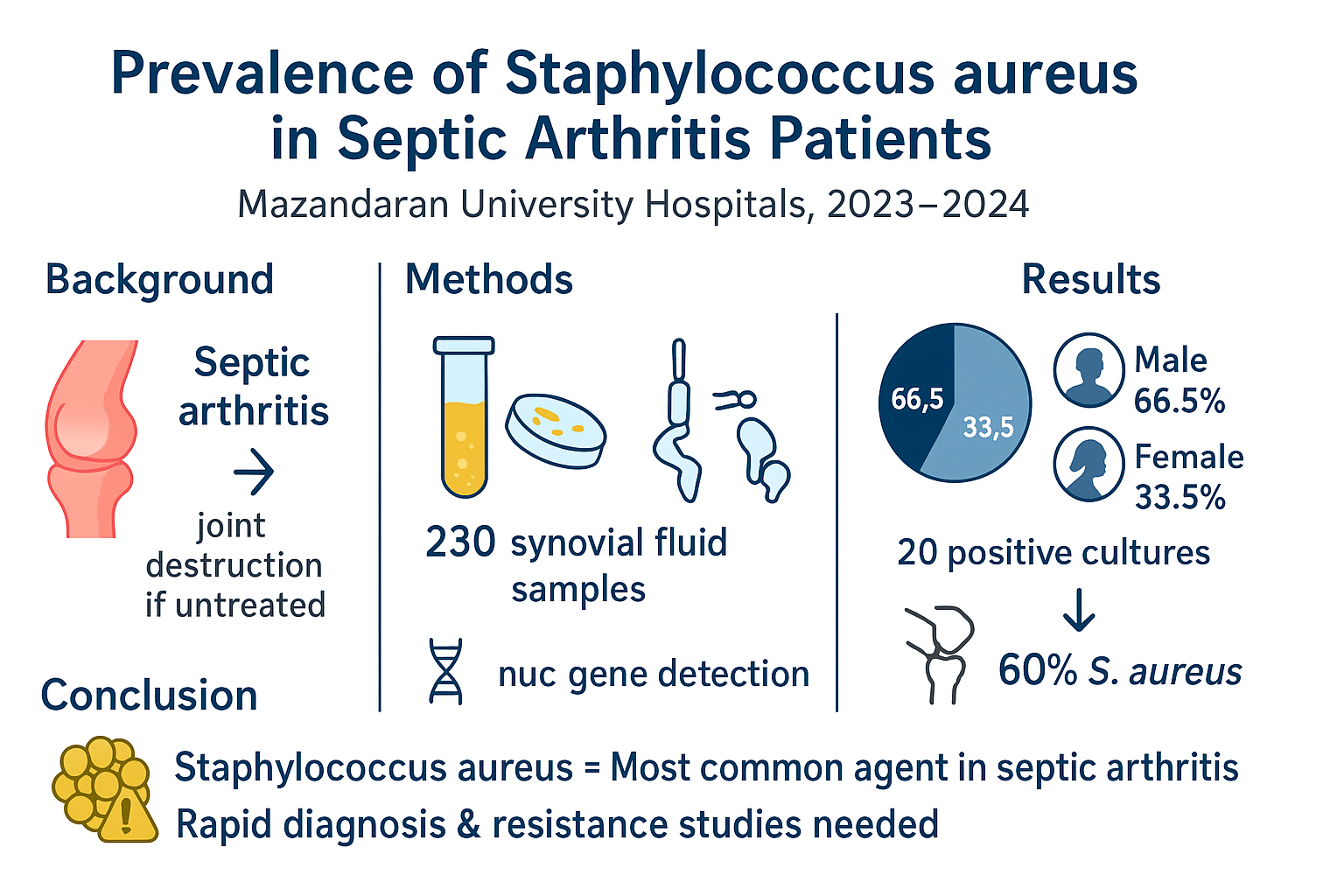Volume 35, Issue 250 (11-2025)
J Mazandaran Univ Med Sci 2025, 35(250): 206-211 |
Back to browse issues page
Download citation:
BibTeX | RIS | EndNote | Medlars | ProCite | Reference Manager | RefWorks
Send citation to:



BibTeX | RIS | EndNote | Medlars | ProCite | Reference Manager | RefWorks
Send citation to:
Azadeh H, Gholami M, Agh M, Ahanjan M. Assessment of the Frequency of Staphylococcus aureus in Synovial Fluid Samples from Patients with Septic
Arthritis in the Teaching Hospitals of Mazandaran
University of Medical Sciences. J Mazandaran Univ Med Sci 2025; 35 (250) :206-211
URL: http://jmums.mazums.ac.ir/article-1-21589-en.html
URL: http://jmums.mazums.ac.ir/article-1-21589-en.html
Abstract: (538 Views)
Background and purpose: Bacterial (septic) arthritis is a severe and rapidly progressive form of arthritis that can lead to irreversible joint destruction. Bacteria may enter the joint during surgical procedures or, less commonly, through joint aspiration or injection. Advanced age, a compromised immune system, and a history of joint disease are recognized predisposing factors for this condition. Patients with septic arthritis typically present with high fever, joint swelling, inflammation, pain, and restricted range of motion in the affected joint(s). This study aimed to determine the prevalence of Staphylococcus aureus in the synovial fluid of patients diagnosed with septic arthritis and hospitalized in the teaching hospitals affiliated with Mazandaran University of Medical Sciences. Septic arthritis represents a serious infectious disease of the joints that can cause severe complications and permanent damage if not promptly diagnosed and treated. The most common causative pathogen is S. aureus.
Materials and methods: This descriptive cross-sectional study, conducted from 2023 to 2024, included 230 synovial fluid samples obtained from patients diagnosed with septic arthritis. The samples were cultured on specific media, and final identification of the isolates was performed using standard microbiological techniques and molecular testing for the nuc gene. The data were analyzed using SPSS software.
Results: Among the 230 patients included in the study, 66.5% were male and 33.5% were female. The knee joint was the most frequently affected site (53.5%), followed by the shoulder and elbow joints. Out of 20 culture-positive samples, 12 cases (60%) were identified as S. aureus. A significant association was found between patient age and positive culture results (P = 0.043).
Conclusion: S. aureus was identified as the most prevalent causative agent of septic arthritis. These findings highlight the critical importance of prompt and accurate diagnosis of joint infections to prevent long-term complications and irreversible joint damage. Future research is recommended to investigate antibiotic resistance patterns and develop effective treatment strategies to improve clinical outcomes in affected patients.
Materials and methods: This descriptive cross-sectional study, conducted from 2023 to 2024, included 230 synovial fluid samples obtained from patients diagnosed with septic arthritis. The samples were cultured on specific media, and final identification of the isolates was performed using standard microbiological techniques and molecular testing for the nuc gene. The data were analyzed using SPSS software.
Results: Among the 230 patients included in the study, 66.5% were male and 33.5% were female. The knee joint was the most frequently affected site (53.5%), followed by the shoulder and elbow joints. Out of 20 culture-positive samples, 12 cases (60%) were identified as S. aureus. A significant association was found between patient age and positive culture results (P = 0.043).
Conclusion: S. aureus was identified as the most prevalent causative agent of septic arthritis. These findings highlight the critical importance of prompt and accurate diagnosis of joint infections to prevent long-term complications and irreversible joint damage. Future research is recommended to investigate antibiotic resistance patterns and develop effective treatment strategies to improve clinical outcomes in affected patients.
Type of Study: Brief Report |
Subject:
Microbiology
Send email to the article author
| Rights and permissions | |
 |
This work is licensed under a Creative Commons Attribution-NonCommercial 4.0 International License. |







